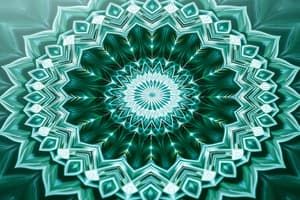Podcast
Questions and Answers
What is a characteristic of a pattern in nature and human-made design?
What is a characteristic of a pattern in nature and human-made design?
- It is only found in abstract ideas.
- It is always complex.
- It is irregular and unpredictable.
- It repeats in a predictable manner. (correct)
How is reflection in symmetry defined?
How is reflection in symmetry defined?
- It does not affect the position of points.
- It consists of a mirror line mapping points across it. (correct)
- It is a type of bilateral symmetry.
- It involves rotation around a central point.
What distinguishes bilateral symmetry from other forms of symmetry?
What distinguishes bilateral symmetry from other forms of symmetry?
- It can have multiple mirror axes.
- It requires the object to be divided into unequal halves.
- It involves only one mirror axis. (correct)
- It uses rotational angles to establish symmetry.
What does rotation in symmetry refer to?
What does rotation in symmetry refer to?
What is NOT a learning outcome for the chapter on the nature of mathematics?
What is NOT a learning outcome for the chapter on the nature of mathematics?
Which of the following is TRUE about the nature of mathematics?
Which of the following is TRUE about the nature of mathematics?
Why is the concept of symmetry important in mathematics?
Why is the concept of symmetry important in mathematics?
What is the purpose of the spotted pattern in hyenas?
What is the purpose of the spotted pattern in hyenas?
Which statement best describes the importance of articulating the value of mathematics in life?
Which statement best describes the importance of articulating the value of mathematics in life?
What is the first number in the Fibonacci sequence?
What is the first number in the Fibonacci sequence?
Which of the following operations would likely involve taking a photograph of an object in nature?
Which of the following operations would likely involve taking a photograph of an object in nature?
How does the Fibonacci sequence determine the number of rabbit pairs after one year, starting with one pair?
How does the Fibonacci sequence determine the number of rabbit pairs after one year, starting with one pair?
In which year was the original problem investigated by Fibonacci presented?
In which year was the original problem investigated by Fibonacci presented?
What is the total number of pairs of rabbits at the end of one year, starting from one pair?
What is the total number of pairs of rabbits at the end of one year, starting from one pair?
What colors can be found in the spotted patterns of hyenas?
What colors can be found in the spotted patterns of hyenas?
Which mathematical concept is illustrated by the pattern in which the Fibonacci sequence develops?
Which mathematical concept is illustrated by the pattern in which the Fibonacci sequence develops?
What geometric shape do many viruses assume?
What geometric shape do many viruses assume?
Which astronomical events can be predicted using mathematics?
Which astronomical events can be predicted using mathematics?
How far in advance can meteorologists typically predict weather patterns?
How far in advance can meteorologists typically predict weather patterns?
What role does mathematics play in controlling the spread of diseases?
What role does mathematics play in controlling the spread of diseases?
In which of the following areas is mathematics NOT commonly applied?
In which of the following areas is mathematics NOT commonly applied?
What mathematical concept can help predict natural phenomena such as tides?
What mathematical concept can help predict natural phenomena such as tides?
Which of the following is a benefit of mathematical modeling in medicine?
Which of the following is a benefit of mathematical modeling in medicine?
Which natural phenomenon is more challenging to predict compared to lunar and solar eclipses?
Which natural phenomenon is more challenging to predict compared to lunar and solar eclipses?
What is the formula for the Fibonacci sequence?
What is the formula for the Fibonacci sequence?
Which of the following flowers typically has 8 petals?
Which of the following flowers typically has 8 petals?
In nature, how are Fibonacci numbers often observed?
In nature, how are Fibonacci numbers often observed?
What is the first Fibonacci number?
What is the first Fibonacci number?
What number of petals does a Shasta daisy commonly have?
What number of petals does a Shasta daisy commonly have?
Which of the following shapes closely follows the pattern of a spiral drawn in Fibonacci rectangles?
Which of the following shapes closely follows the pattern of a spiral drawn in Fibonacci rectangles?
Which number follows 55 in the Fibonacci sequence?
Which number follows 55 in the Fibonacci sequence?
Which flower has the highest number of petals listed in the Fibonacci context provided?
Which flower has the highest number of petals listed in the Fibonacci context provided?
What can you count to test the principles of the Fibonacci sequence in nature?
What can you count to test the principles of the Fibonacci sequence in nature?
What is the second Fibonacci number?
What is the second Fibonacci number?
What defines the golden angle in a circle?
What defines the golden angle in a circle?
How is the ratio of the lengths of arcs related to the golden ratio?
How is the ratio of the lengths of arcs related to the golden ratio?
What approximate measure does the golden angle have?
What approximate measure does the golden angle have?
Which relationship did Kepler discover concerning planets?
Which relationship did Kepler discover concerning planets?
What is the significance of the constant discovered by Kepler?
What is the significance of the constant discovered by Kepler?
How can rainbow colors be mathematically described?
How can rainbow colors be mathematically described?
What does mathematics help us recognize in the world?
What does mathematics help us recognize in the world?
What is the correct formula that Kepler used to relate distance and orbital period?
What is the correct formula that Kepler used to relate distance and orbital period?
Flashcards are hidden until you start studying
Study Notes
Patterns and Numbers in Nature and the World
- A pattern is a predictable regularity in the world, design, or abstract ideas.
- Symmetry is a regularity characterized by operations that leave an object unchanged.
- Reflection (line or mirror symmetry) maps points across a line at equal distances.
- Bilateral symmetry is a reflection with one mirror axis, dividing an organism into two equal halves.
- Rotation symmetry fixes one point (rotocenter) and rotates everything around it by a set angle. Examples include tiger stripes and hyena spots, which serve camouflage purposes.
Fibonacci Sequence
- The Fibonacci sequence starts 1, 1, and each following number is the sum of the two preceding numbers (e.g., 1, 1, 2, 3, 5, 8, 13...).
- Fibonacci's original problem (1202, Liber Abaci) concerned rabbit breeding under ideal conditions.
- The Fibonacci sequence is defined by the recurrence relation Fn = Fn-1 + Fn-2, with F1 = 1 and F2 = 1.
- The Fibonacci sequence appears in nature, such as in the arrangement of petals in flowers (e.g., lilies have 3, daisies have 34, 55, or 89 petals), pine cones, and sunflower seed spirals (e.g., 21 counterclockwise, 34 clockwise).
- The arrangement of these spirals often relate to Fibonacci numbers.
- Fibonacci numbers are also seen in the spiral pattern of seashells.
Golden Angle
- The golden angle is the smaller angle created by dividing a circle's circumference according to the golden ratio (approximately 137.50776°).
- The golden angle is related to the arrangement of leaves and florets in some plants, maximizing light exposure.
Importance of Math in Life
- Mathematics helps organize patterns and regularities in the world, both numerical (like Kepler's planetary laws where d³/o² = constant) and geometric (e.g., circles in rainbows and ripples, icosahedral shape of viruses).
- Mathematics helps predict the behavior of nature and the world (e.g., lunar and solar eclipses, tides).
- Mathematics helps control nature and occurrences for our own ends (e.g., mathematical modeling in controlling disease spread).
Studying That Suits You
Use AI to generate personalized quizzes and flashcards to suit your learning preferences.




